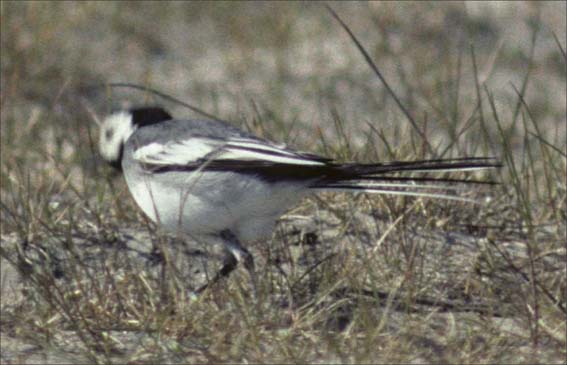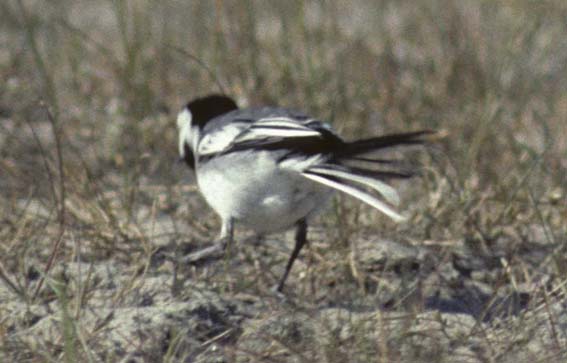Eastern and other Wagtails in Europe.
(text vs may 3, 2007)
On the 8th May 2001 I had a brief encounter with an odd-looking White Wagtail Motacilla alba on the Maasvlakte in the Port of Rotterdam. The bird showed a large amount of white on it's wing coverts . In spite of the strong wind I was able to make three pictures of this bird.
Only after reading the chapter on white wagtails in Alström et al's excellent identification guide (2003) I realized that the odd wagtail I had seen in 2001 could be of eastern origin.
As the bird had a white throat (see picture b) I concluded that the bird could belong to the eastern subspecies baicalensis. Alström et al say on baicalensis' (p.342): 'adult male summer resembles eastern populations of alba (shows extensive white on median and greater coverts, often forming a large white panel) but differs by having white upper throat.'
According to Alström et al northernmost breeders of alba, personata, baicalensis and ocularis arrive on the breeding grounds from mid-April to mid-May. A migrant white wagtail in May can be considered late in The Netherlands as local alba are already breeding and the peak of yarrellii 's migration (mid-March to mid-April) is over.
Alström et al say that: 'The taxa alba (including 'dukhunensis'), baicalensis, personata and ocularis intergrade where their ranges meet.
Their map on p.387 shows that alba and ocularis intergrade with alba in West central Siberia at ca 95E, with personata and baicalensis in central Asia.
I presented my pictures and conclusion that this bird must be M.a.baicalensis to Dr.Per Alström, Swedish Museum of Natural History in Stockholm, and he comments as follows:
'I would still like to see the entire throat; in theory, there could be a dark stripe or a some dark spots centrally. Yes, wing pattern indicates a bird of eastern origin. No point in trying to stretch it.'
If only I had been able to take a picture from the front of the bird! However, there is no doubt my bird is an 'eastern' White Wagtail and came from far. As such it is one of only a handfull eastern birds which have been observed in Europe and may be the first for Europe showing characters of M.a.baicalensis however several birds seen in spring in Sweden may be hybrids M.a.baicalensis x M.a.personata and or alba rather than hybrids between alba and yarrellii as has been suggested.
There have been occurrences of other eastern White Wagtails races in Western Europe:
In Britain three records (out of a possible four) of Chinese Black-backed Wagtail Motacilla (alba) leucopsis have been accepted by the UK400 Club -:
-An autumn adult at Salakee Farm, St Mary's (Scilly) on 19th October 1981 (Nigel Redman et al) (Isles of Scilly Bird Report 1981), Green Farm and Pelistry Lane, St Mary's (Scilly);
-17th-19th October 1986 (many observers; LGRE et al) and a summer-plumaged adult at Seaham (Durham); -5th-6th April 2005 (Steve Addinall et al).
In Norway a Motacilla alba personata stayed from November 2003 to April 2004.
In Sweden an adult male Motacilla alba personata was found on Òland on 29th April 2006.
Reference: Alström, Per & Krister Mild & Bill Zetterström.2003: Pipits & Wagtails of Europe, Asia and North America. London. Helm Identification Guides.
Acknowledgement: I thank Dr. Per Alström, Lee G.R.Evans, Frode Falkenberg and Magnus Hellstrom for their interesting comments and or supplying more details on eastern White Wagtails.
I have added pictures of White Wagtails Motacilla a. alba and Pied Wagtails Motacilla a.yarrellii showing breeding, autumn, winter and or immature plumages. I have tried to determine sex and age which is not always easy as even Lars Svensson,1992, says: ´More research is required to establish the range of individual variation and any pitfalls.´ Therefore corrections are welcome.
Reference: Svensson, Lars.1992.Identification Guide to European Passerines, 4th ed. Stockholm.




